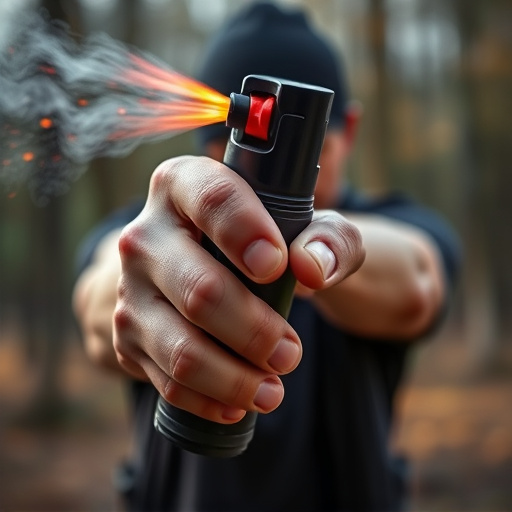Pepper spray, containing capsaicin, is an effective non-lethal defense against aggressive dogs, temporarily incapacitating them and providing escape time. Tactical systems with advanced targeting technology offer robust protection for law enforcement and security. Training is crucial to ensure safe and swift usage, including proper activation, de-escalation, and safety procedures to prevent accidents and minimize collateral damage.
“Unleashing a powerful yet strategic tool in the realm of personal defense, this article explores the tactical application of inflammatory spray against aggressive dogs. With an emphasis on pepper spray as a game-changer, we delve into its efficacy and how it can be utilized effectively. From understanding the spray’s mechanics to deciphering the key components of a comprehensive defense system, readers will gain insights into training and safety protocols. Discover how this innovative approach can provide a strategic edge in navigating potential dog encounters.”
- Understanding Pepper Spray and Its Efficacy Against Dogs
- Components of a Tactical Inflammatory Spray Defense System
- Training and Safety Measures for Optimal Effectiveness
Understanding Pepper Spray and Its Efficacy Against Dogs
Pepper spray, a tactical inflammatory spray defense system, has established itself as a powerful tool for personal protection against dogs. When deployed correctly, it can effectively deter and incapacitate aggressive canines, providing individuals with precious time to escape or seek help. The primary active ingredient in pepper spray is capsaicin, a compound derived from chili peppers that stimulates the sensory neurons, causing local pain and temporary blindness. This disruption significantly impairs a dog’s ability to attack, making it an ideal defense mechanism for encounters with these powerful animals.
Research suggests that pepper spray can be highly effective against dogs, especially when used in specific situations. For instance, aiming for the face and eyes is crucial as these areas are sensitive, leading to faster incapacitation. The potency of pepper spray varies by brand and concentration, with higher strengths offering longer-lasting effects. However, it’s essential to understand that not all dogs will respond identically; larger breeds or those trained for combat might require a stronger spray or alternative deterrents.
Components of a Tactical Inflammatory Spray Defense System
A tactical inflammatory spray defense system is a powerful tool designed to deter and incapacitate aggressive dogs, offering a non-lethal solution for law enforcement and security personnel facing canine threats. The core components of such a system include a specialized pepper spray formulation, a robust delivery mechanism, and advanced targeting technology.
The primary active ingredient in these sprays is capsaicin, derived from chili peppers, which provokes a burning sensation and temporary blindness when sprayed into the eyes and respiratory system of the targeted dog. The spray is typically contained within a compact, ergonomic canister that allows for easy handling and quick deployment. Additionally, integrated safety features ensure the sprayer remains secure until needed, preventing accidental discharge. Targeting systems often involve advanced nozzles or valves that can precisely direct the spray stream to minimize collateral damage and maximize effectiveness against the dog’s sensitive areas.
Training and Safety Measures for Optimal Effectiveness
Training is a pivotal aspect of ensuring the optimal effectiveness of a tactical inflammatory spray defense system, particularly when aiming to deter aggressive dogs. Law enforcement officers and individuals alike must undergo comprehensive instruction on proper usage, including understanding the spray’s range, activation mechanisms, and de-escalation strategies. Regular practice drills in controlled environments simulate various scenarios, enabling users to respond swiftly and accurately under pressure. This preparation is crucial for minimizing the risk of harm to both the individual and the animal during confrontational situations.
Safety measures are equally critical when employing a pepper spray defense against dogs. Users must be educated on the potential risks and side effects of the spray, such as respiratory irritation or temporary blindness, not only for themselves but also for nearby bystanders. Adequate ventilation in training areas is essential to mitigate these risks. Additionally, regular maintenance and inspection of the spray devices ensure their reliable operation when needed most. Proper storage and handling procedures further safeguard against accidental discharge, emphasizing the importance of continuous training and vigilance in maintaining a safe and effective defense system.
A tactical inflammatory spray defense system, particularly designed for pepper spray defense against dogs, offers a powerful non-lethal solution for law enforcement and personal safety. By understanding the efficacy of pepper spray against canine aggression and the key components of an effective system, individuals can better prepare to navigate potentially dangerous encounters. Proper training and safety measures are paramount to ensure the optimal effectiveness of this tool while minimizing risks. Embracing these strategies allows users to protect themselves and their communities in a safe, strategic manner.
